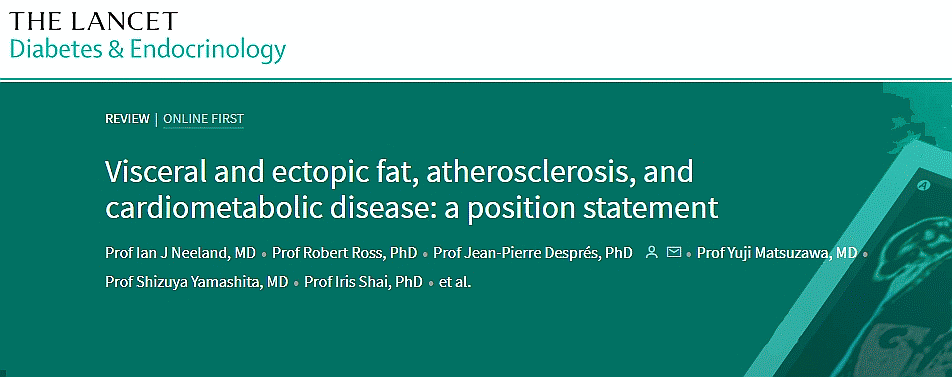
In 1983, using computed tomography, an imaging technique that was not used at the time for measuring body fat, a team of researchers from the Department of Internal Medicine at Osaka University led by Prof. Yuji Matsuzawa showed for the first time that there were substantial individual differences in the way human beings would store their body fat. Indeed, these Japanese researchers published fascinating images showing that despite similar body weights, some people would accumulate significant amounts of fat in their abdominal cavity, this fat being invisible from outside the body. They called that fat visceral fat and its excess, visceral obesity. In 1986, intrigued by these findings and at the very beginning of his career as an independent researcher at Université Laval, Prof. Jean-Pierre Després of the Department of Kinesiology at the Faculty of Medicine, launched with his colleagues a series of imaging studies where computed tomography would also be systematically used to assess the distribution of body fat (including abdominal fat) and its relationship to health outcomes. Soon enough, at the dawn of the 1990s, his team reported results that clearly showed the limits of the ideal body weight concept (body mass index – BMI) and the key importance of visceral fat (the fat located in the abdominal cavity) as a risk factor for chronic diseases such as cardiovascular diseases and type 2 diabetes.
Thus, these early concordant results from the teams of the University of Osaka and Université Laval, initially received by the scientific community with curiosity, but also with legitimate skepticism, subsequently led many groups of international investigators to use medical imaging (initially computed tomography and, more recently, magnetic resonance imaging) in order to study the links between the regional distribution of body fat (including visceral adiposity) and health. The work carried out by these different teams over 30 years has unequivocally confirmed the importance of measuring visceral adiposity and that the assessment in the clinic of the health risks of overweight and obesity on the basis of the BMI was not accurate and sometimes even misleading. In fact, even among individuals with similar healthy body weights, it is now well documented that the subgroup of individuals with an excess of visceral fat is at much greater risk for health complications than individuals whose fat is visible, that is, located subcutaneously.
Given the major gap between the current science on the risk of visceral obesity and the little attention that it still receives in clinical practice, the International Atherosclerosis Society (IAS) in conjunction with the International Chair on Cardiometabolic Risk (ICCR) of Université Laval agreed to hold a working meeting in Prague, on April 24, 2017, in order to develop a joint consensual position on visceral obesity as a health hazard. Therefore, an international expert group was formed under the codirection of Profs. Jean-Pierre Després and Yuji Matsuzawa and these experts began to work together to produce a position paper on the science of visceral obesity as a health hazard, on how it can be evaluated with simple tools in clinical practice, and on how it could be managed by therapeutic approaches such as lifestyle, drug therapy and even, in some cases, surgery.
The expert group also made recommendations on areas where additional research work would be needed. For instance, imaging studies have also shown that visceral obesity is often accompanied by an accumulation of fat in normally lean tissues such as the liver, heart, and skeletal muscles and that this fat, called ectopic fat, also causes harm to health. The role of ectopic fat in modulating the health risk of visceral obesity is currently the subject of important investigations conducted in many laboratories around the world.
The consensus document emanating from the work of these international experts is published in the prestigious medical journal The Lancet Diabetes & Endocrinology. Having been a major influence in this collective effort, Prof. Matsuzawa mentions, “This is a major publication which emphasizes to physicians the need beyond the management of the risk of atherosclerosis and cardiovascular disease mediated by LDL-cholesterol. Indeed, many patients treated with statins, molecules very effective for lowering LDL-cholesterol levels, remain at risk for cardiovascular accidents because of their visceral obesity.”
Another leader behind this consensus exercise and corresponding author of the paper, Prof. Després, adds, “Despite 30 years of research on the subject, visceral obesity is most often not properly evaluated in clinical practice as most physicians still rely on the BMI to evaluate the risk of overweight/obesity in their patients. Not only a diagnosis of overweight or obesity based on body weight stigmatizes patients, but the information that it provides could be inaccurate and even misleading.” He also says, “We hope that this important international consensus position paper will stimulate the health authorities in different countries to align their messages and their actions on the scientific evidence available on the risk of visceral obesity.”
In closing, Prof. Raoul Santos, president of the IAS, mentioned, “The International Atherosclerosis Society has considerable interest and expertise in atherosclerosis and cardiovascular disease. For years, we have emphasized the importance of measuring and targeting modifiable risk factors such as, among others, LDL-cholesterol, blood pressure, smoking and diabetes. This consensus paper underscores how IAS considers visceral obesity as an important and emerging risk factor for premature atherosclerosis and cardiovascular diseases”.